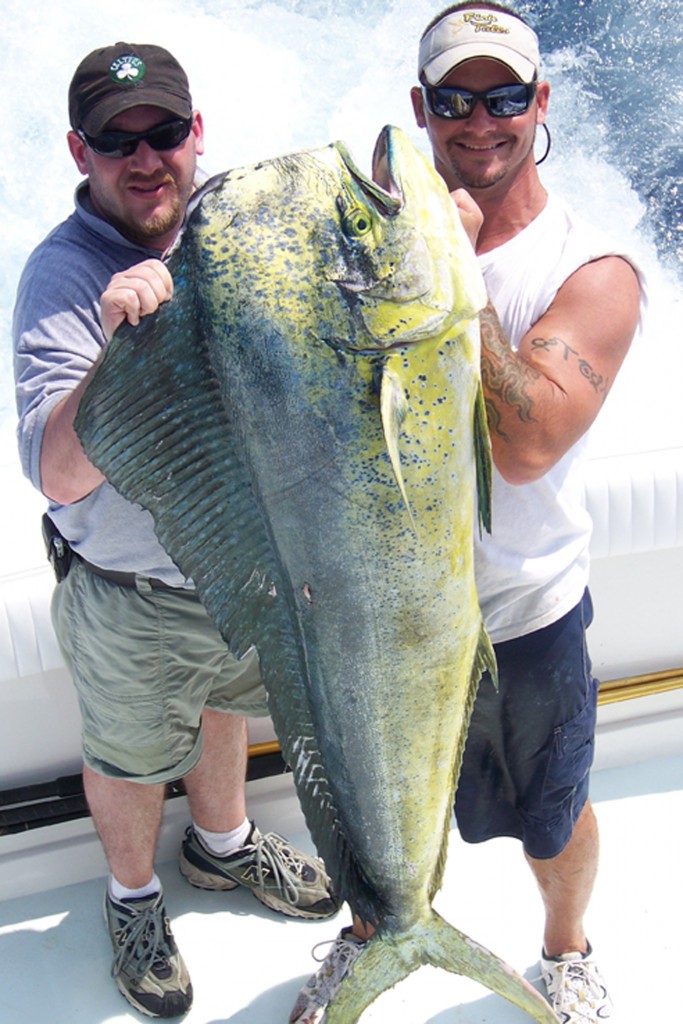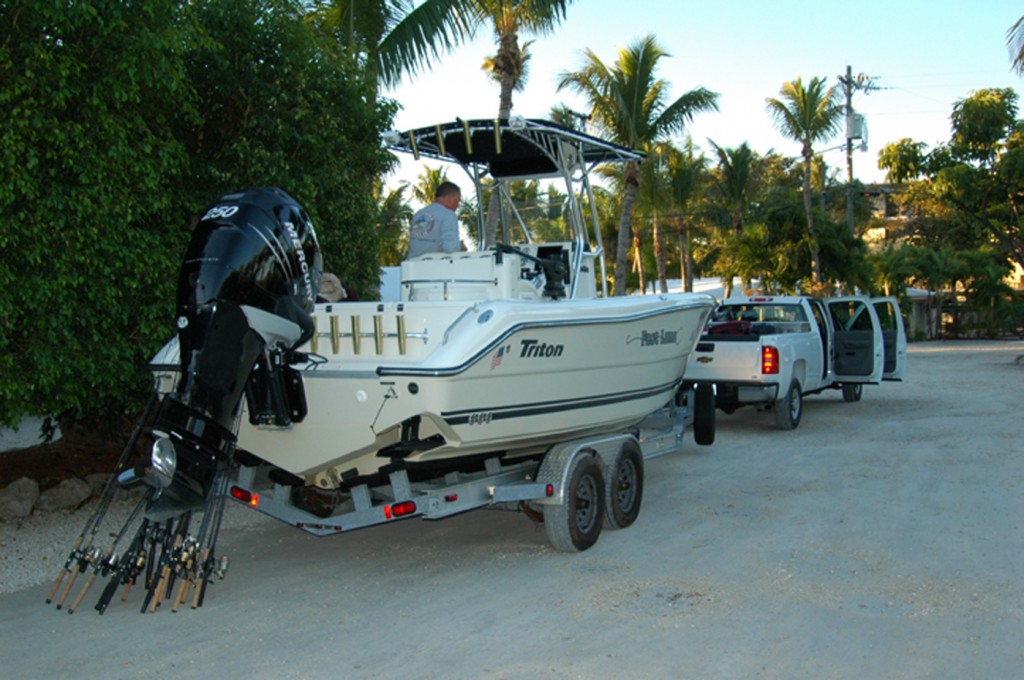August 17, 2016
By David Conway
Seasoned pros on chasing slammers.
 Angler John Gagliastro, left, and mate Jeremy Pfaffendorf with the 70-pound bull caught aboard Capt. Ron Allen's boat in the Keys.
Angler John Gagliastro, left, and mate Jeremy Pfaffendorf with the 70-pound bull caught aboard Capt. Ron Allen's boat in the Keys.
For big dolphin, we're taught to look for one or two frigatebirds low on the water, and often moving against the current. However, don't discount those schools of smaller fish that hang around weedlines. That schoolie you have staked off the bow to keep the school by you? You'd better be prepared for the bigger bull to come up and take it. It happens often.
“Somebody big is under there watching you and those fish,” Capt. Ron Allen of Fish Tales Sport Fishing in Islamorada says, “whether it's a blue marlin, wahoo or a few bigger dolphin, they're going to be there.”
That's exactly how Allen, who's fished in the Keys for 30 years, came upon his 70-pounder last spring.
“We had a group of folks who'd never been dolphin fishing before in their lives,” Allen said, recounting the catch, “and so we rounded up some cigar minnows and were catching schoolies, when the big fish came in. He took a bait on a BG 30 spinning reel with 20-pound test, a 50-pound leader and a 5/0 hook, so there was a lot of backing down and chasing going on.”
To get that fish, Allen knew that he could not let it sound or risk breaking it off in trying to raise it, so each time it started down, he'd back the boat and put slack in the line to take the pressure off it. The fight took 45 minutes, and “it was still pretty green when we gaffed it and landed it,” Allen said.
“I'll get four or five 50-pounders and a few 60-pounders each season, but that 70-pounder is quite rare. Personally, I can only recall three in the last 8 years in the Keys. It was just good fortune for us to be there when that fish came in.”
Good conditions for the bigger fish are the same as for the smaller dolphin. The fish orient themselves with the currents. They like good, clear blue water of 72 to 78 degrees—whether that's the Gulf Stream or the Loop Current or one of their eddies. They want plentiful bait, and they'll hunt for it around structure—weeds or flotsam, or below—seamounts, ridges and continental shelf dropoffs. Where and when those conditions exist, you might find the bigger fish—not so much as a factor of the time of year.
“I've caught big dolphin in March and April off South Florida and the Keys, but I've also caught them in June, August and even October,” says Joel Day, a longtime South Florida angler. “Those fish can be there at any time the conditions are good for them, and they might be in a lot shallower water than you'd expect. Also, the bigger fish travel in pairs, a bull and a cow, not in schools.”
In what depths the fish might be traveling varies day to day, depending on where the currents move, carry bait and hit the local reef's edges or bottom structure. So always get an idea of the depths where the fish were the day before—but don't assume they'll be there tomorrow. Listen on the VHF radio for where they are that day, and keep your eyes open.
“One day they'll be 12 miles out,” says veteran Keys captain Alex Adler, of the Kalex, “and the next day they'll be at 29 miles, or 21 miles.”
Now, to target big dolphin, Capt. Allen has a few good strategies. He'll run teasers, fast, and horse ballyhoo, about 12 knots.
“The big dolphin want some big noise,” Allen says. “So I'll run big teasers: Halloween colors, orange and black, or purple and black. On the flatlines, for the bigger fish, I'll use a horse ballyhoo on a bigger softhead lure with the same color as the teaser ahead of it, and on the other side, I look for a dolphin-color teaser, green yellow, and behind it a horse bally with the same color head. I'll throw a few tricks out on the outriggers and pick up speed, and make a lot of noise. In the summertime, the dolphin around here will be out in the deeper water, in the current, and when we troll against the current, I'll slow down my trolling speed a bit, then with the current, I'll speed it up a bit.
“Most guys will run small baits that the decent-size dolphin will take, but I'm really convinced that for the big fish, you really need to run big lures,” Allen says.
Come to think of it, every time I've been aboard with a big dolphin caught trolling, it's hit the largest lure or bait in the spread.
“The second and third week in May, the end of June, and July and August is the best of the big ones,” says Adler, of the Kalex. “If it's rough, we'll troll. If the current is not opposing the wind, you can troll a lot more up at about 6 knots. They have abrasive mouths, so we'll use 60-to 100-pound leader, depending on the situation and the seas, and nothing bigger than a 7/0 hook, with live bait, dead bait, bonito strips, whole squid, cigar minnows, pilchards.”
One of Adler's favorite techniques for the slammers is going deep. Like smart snappers and big kings at oil rigs in the Gulf, big dolphin will often lurk below the feeding frenzy of schoolie dolphin above, picking off pieces here and there, and waiting for their best moments to strike a weak fish. Moreover, they spend more time deep than most anglers suspect—often at depths of 400 feet, feeding at night, and on baitfish schools that never surface. Often times anglers won't even drop baits down deep enough to check for the presence of bigger fish, but that's missing big opportunities, especially around structure found floating, like weeds or debris.
 Northeast Florida gets its share of bulls, like this one landed off St. Augustine.
Northeast Florida gets its share of bulls, like this one landed off St. Augustine.
“In the right conditions, don't be afraid to put down lures on cigar leads, and you can fish for them with downriggers, too. We only see about 5 percent of the fish that are coming through up on the surface,” says Adler.
Out of Miami, Capt. Jimbo Thomas of the Thomas Flyer likes to run ‘n' gun for big dolphin.
“Good conditions for Miami would be an east wind, or a southeast wind. Starting about in May, we'll get a run of decent ones, typically chasing flyingfish, indicated by frigatebirds, typically not too far out, in 200 to 500 feet of water, which here is about 4 to 6 miles out off the beach,” Thomas says.
“We'll bring our binoculars and just run ‘n' gun, scanning the horizon for birds or weeds or structure. We like to cover territory to find the fish, so we'll sight fish and not troll, so that when we see something, we can pick up and run quickly. Once we get near the activity, we slow down and get out the live baits. When dolphin are chasing flyingfish they'll eat just about anything that you throw at them. We've determined over the years that they'll feed off of sounds, targeting the flyingfish as it hits the water. If you get your bait anywhere near their vicinity they'll turn around and hit it.”
Thomas likes to say that catching the fish is not a problem, it's finding the fish. Typically when you hook a big one, it will gobble the bait down and get well-hooked.
“The main thing is don't rush it,” he says. “Most big dolphin are lost when they're near the boat, when the anglers underestimate how strong the fish are and how much energy they have left, and they're in an unnecessary rush. Make sure that when you take that leader you can control the fish, and when you do gaff ‘em, make sure you get ‘em in the boat in one motion.”
Still, for a 40-pound dolphin on 20-pound test, expect a 20-minute to a 45-minute fight.
Thomas and his crew use spinning tackle, 20-pound monofilament, 50-pound leader, no swivels, instead, a double line—5 to 6 feet of monofilament with an Albright knot, and a 5/0 Mustad Big Gun hook. They'll set the drag at normal settings for 20-pound line, about 4 or 5 pounds.
“We don't use a real long leader because a lot of times we'll be casting to fish. Get in front of the fish. If you have a tuna tower that helps, because it's a lot easier to see them, but go out front of them and get some baits in the water, and they'll find you. Chasing birds, most people make the mistake of following the frigate. But if there are some gulls, they'll stay right with the fish. If the frigate comes down on the water, then he's right on the fish, but until then, stay on the gulls.”
 Triton in tow, La Siesta, Islamorada.
Triton in tow, La Siesta, Islamorada.
Lodging for Boaters: Islamorada
Want to tow your boat to get the first crack at northbound dolphin this spring? Go to The Keys.
Every year for the last decade, Kevin Colston from Kentucky has towed his 24-foot Triton down to Islamorada for a month of fishing, where he's stayed at La Siesta Resort, one of a number of operations that have boat dockage and ramps in the area.
Colston advices those interested in the trip to “make sure you find a place that has good dockage, with good deep water in and out, because it can be treacherous navigating in The Keys, especially if you're not familiar with the waters. And prepare before you get here, and budget accordingly. A lot of times you'll get a room but you might not find a place for your boat.”
La Siesta Resort has two marinas, one on the oceanside, capable of handling center consoles up to 26 feet, designed for those at the resort who want their boat close by. They also have a bayside marina on the Gulfside, with 21 slips, that caters to transient boats up to 45-foot in length. The Gulfside marina has water and showers and electricity and a shop with live and frozen baits and ninety octane, no-ethanol fuel. Plenty of guides work out of that marina, too.
Ray Kooser, La Siesta manager and dockmaster, advises visiting boaters, “Make sure that your licensing is in place and your boat is strapped down, because local authorities look to ticket such infractions.”
La Siesta's accommodations have different floor plans and layouts, though every one of them has a kitchen, either a full kitchen or an efficiency. One bedrooms start at $149 per night and there's a 3-bedroom house for $359. Two bedrooms and cottages fall between those rates. There's also a 5-bedroom house for rent. Dockage is $2/foot/day and the daily launch and trailer storage fee is $22.
Other resorts with docks and boat ramps in Islamorada and nearby are listed below. Before booking, be sure to check that the hotel's docks and ramps will accommodate your boat.
Coral Bay Resort: www.coralbayresort.com; (305) 664-5568
Keys Villa: www.keysvilla.com; (866) 664-4163
La Jolla Resort: www.lajollaresort.com; (888) 664-9213
Ragged Edge Motel: www.ragged-edge.com; (305) 852-5389
Sands of Islamorada: www.sandsofislamorada.com. (888) 741-4518
SeaScape Marina: www.seascapemotelandmarina.com; (305) 743-6212
On Long Key: Edgewater Lodge: www.edgewaterlodge.com (305) 664-2662
